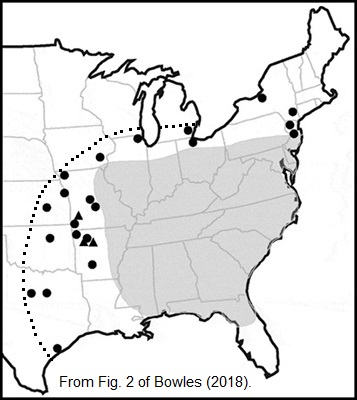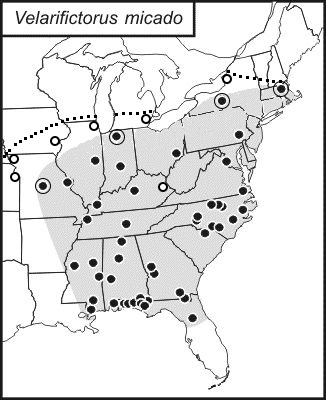



|

|
The two maps at the top of this page are sufficient to conclude what could be learned from SINA about the distribution of the Japanese burrowing cricket in 1977, 2003, 2017, and 2018. What is really important is that the species now (2019) has the general distribution indicated by the dotted line on the west and the north of the maps and is still not known from Florida south of Gainesville.
The shaded area on the map at right shows the known distribution of V. micado prior to the publication of the map at left (Bowles 2018). Added to the map-at-right are open circles and a dotted line that show how Bowles’s paper changed the known northward distribution of V. micado. The map-at-left is the eastern half of the figure that Bowles (2018) used to show his new records for V. micado. Added to the map-at-left is an extension of the dotted line of the map-at-right to show how far Bowles (2018) extended the known distribution of the species into areas of lower rainfall.
In 2018, D. E. Bowles published an article that expanded the known range of V. micado significantly westward. His new records, based principally on photographs of specimens on BugGuide and iNaturalist are mapped on his Fig. 2. [No records fell west of the 100th meridian, so the US map used is cropped at the meridian.]
Most of the records that established the shaded area in the two figures are from Walker (1977a.) Only the four dots enclosed by larger circles are from later than 1977.
The Columbia, Missouri, record is based on a song recorded by Vince Marshall, Sep.-Oct. 2000. The north-most Indiana record is from a 29 Dec 2014 email from Carl Strang, who recognized that it was far north of where V. micado had been found before. Because the species was in large numbers in a disturbed area, he thought that "they almost certainly have been building their numbers over at least a couple of years, demonstrating their abilities to survive our winters." The New York record is from a 20 Sep 2017 email from Brandon Woo in which he reported finding several individuals of this species on the Cornell campus. This range extension is similar to previous ones in that the species was found in a landscaped area rather than a natural habitat. The Boston record, also from Woo, was of males audiorecorded in a city park, similar to other reports of this species from urban sites.